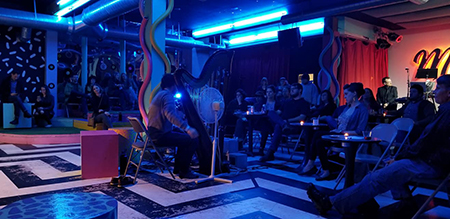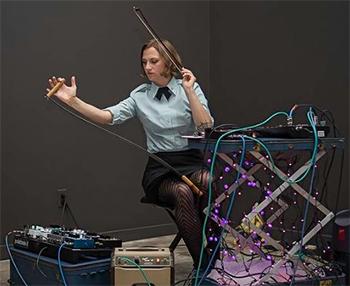by Rory O’Donoghue

McDaniel and producer Jacob Kirkwood headlined with a concert version of their “co-composed live electroacoustic score” for Cleveland Public Theatre’s production of Fire on the Water. One-woman choir Christa “UNO Lady” Ebert, harpist Stephan Haluska, and a special menu of “signature cocktails” filled out the lineup in a night of wit, depth, and delight presented in partnership between Mahall’s Main Stage and fp (Fresh Perspectives).
Fire on the Water is a collection of brief plays inspired by the 1969 burning of the Cuyahoga River, and McDaniel’s and Kirkwood’s music captured the drama of the scene even without its theatrical context. The music coursed along organically, crackling with charged drive. Kirkwood created a subtext of tasteful beats as McDaniel speckled them at the keyboard, joining percussionist Mell Csicsila in concocting a buoyant groove. Devin Hinzo’s oboe (and later, English horn) swirled around on top with gentle melodies, layered in subtle contrast to the more rhythmic undercurrent. Violinist Ariel Karaś countered and balanced those two arenas, at times sweeping elegiacally along with Hinzo and at others scrubbing away at double stops with verve.

With its highly adaptable space, Mahall’s is a perfect venue for multimedia productions. Stephan Haluska took advantage of this with his opening act, setting up his harp and assorted extra hardware at the center of the room opposite the stage (pictured above). Haluska’s electro-acoustic compositions explore the broad terrain between traditional and experimental harp techniques, utilizing a variety of different objects to prepare, retool, amplify, and distort. He played one seamless, 20-minute free improvisation that ebbed and flowed with musical DNA. He began by manipulating a tower fan, angling its path through the strings to generate low frequencies and to lightly tinkle the chimes set up on the other side. From there, the piece followed a large arc marked by stasis, tension, and release. Sonic bubbles emerged from the dreamscape, arpeggios cascaded, and strings sounded in myriad ways.

Although a vodka cranberry wasn’t readily available to grab, the lovely cocktail menu included “The Pegu Club” (lime, angostura and orange bitters, orange curaçao, gin), “A Familiar-Tail” (sweet vermouth, artichoke amaro, rye whiskey), and “Twitterpated” (lime, honey, fresh raspberry, house-infused vanilla bean tequila). Twitterpated in hand, I happily settled into the final piece, McDaniel’s and Kirkwood’s Difference and Repetition, which was initially conceived as a dance score (also for Cleveland Public Theater). Galvanized with direction, the piece reaffirmed the duo’s fresh collaborative talents — crisp, exciting, and relevant.
Published on ClevelandClassical.com April 8, 2019.
Click here for a printable copy of this article



